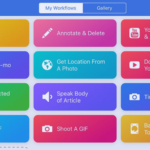If you wish to begin monitoring what number of energy you eat—whether or not for weight reduction, weight achieve, or simply out of curiosity—right here’s a primer. Calorie monitoring is fairly simple when you’ve gotten the grasp of it, however getting began might be complicated. With the fitting instruments and the fitting habits, nevertheless, you’ll be on prime of your individual private calorie numbers very quickly.
What are energy and why do individuals rely them?
Energy are a measure of power. The extra train you do, for instance, the extra energy that you must gas that exercise. The whole lot you eat has a calorie quantity hooked up to it (whether or not it’s on a label or not). Typically, we eat about the identical variety of energy we burn.
Amazingly, our our bodies can preserve us at a roughly regular weight by making us hungrier if we haven’t eaten sufficient energy in the present day, or making us really feel full if we’ve had so much. That mentioned, constantly consuming lower than you burn ends in weight reduction; consuming greater than you burn ends in weight achieve.
How do I understand how many energy I ought to eat?
More often than not, you need to eat roughly the identical variety of energy every day that your physique burns. That quantity varies from individual to individual. A 4’9”, 100-pound lady who solely does mild train may burn 1,440 energy per day. A six-foot, 280-pound man who does heavy exercises twice a day may burn 4,309. Most of us are someplace in between, within the 2,000 to three,000 calorie vary.
I focus on calorie burn somewhat extra right here. Regardless that meals labels use a 2,000-calorie eating regimen to calibrate their “every day values” of assorted vitamins, the reality is that we every burn a unique variety of energy, and most of us burn greater than 2,000. (The common for adults was, years in the past, calculated to be 2,350. The FDA ended up going with 2,000 partially as a result of they thought a spherical quantity was simpler to know.)
So if you need to shed weight, you’ll wish to eat barely lower than you burn. If you wish to achieve weight—as many individuals do once they’re making an attempt to achieve muscle—you’ll wish to eat extra energy than you burn. An excellent rule of thumb is to subtract 200-500 energy from what you burn, and that might be a superb quantity for weight reduction. Do the alternative in the event you’re making an attempt to achieve.
Now that you simply perceive the logic, you simply want a beginning estimate of what number of energy you burn. If you happen to already observe energy, you’ll be able to in all probability determine this out by what you normally eat when your weight is secure. In any other case, plug your data right into a TDEE (complete every day power expenditure) calulator just like the one at tdeecalculator.web. Do not forget that any calculated quantity is barely an estimate, and in the end you’ll discover out whether or not it’s right by noticing what occurs to your weight whenever you eat that quantity.
If you happen to use a Fitbit or different gadget that estimates your calorie burn every day, that is additionally a superb place to get a beginning quantity. Simply keep in mind that that is additionally an estimate, and may nonetheless be off by a number of hundred energy in both path.
How do I learn the way many energy are in a meals?
The simplest method to get a calorie quantity for a meals is to have a look at its label. Or in case your meals doesn’t have a label, seek for the title of the meals plus “energy” and take note of the serving dimension and the supply of the knowledge. For instance, after I google “apple energy,” I get a end result telling me {that a} medium apple, about 3 inches in diameter, is 95 energy. The supply is given because the USDA, which maintains a database of frequent meals objects. Right here’s the entry for apples. It defaults to a 100-gram serving, however you’ll be able to change the “portion” dropdown to point out you the medium apple.
If you’re consuming at a restaurant, calorie counts are generally proven subsequent to every meals merchandise. In the event that they aren’t, examine the restaurant’s web site, or search the restaurant’s title plus “diet data.” Typically there’s a PDF hidden someplace on their web site with a bunch of calorie counts—and, typically, different data like protein and carbohydrate content material.
That mentioned, there’s a less complicated manner that individuals normally use when monitoring energy: You utilize a calorie monitoring app.
What’s the finest calorie monitoring app?
There are tons of fine (or at the least not horrible) calorie monitoring apps on the market. Cronometer is my choose: It’s obtained all of the options you want even within the free model, and it’s goal-neutral, so you should use it whether or not you’re making an attempt to achieve weight, shed weight, or neither.
Essentially the most widespread calorie monitoring app might be MyFitnessPal, which is baffling as a result of it’s simply the worst one on the market. The calorie data is commonly inaccurate, the interface is fairly in-your-face about weight reduction whether or not you’re inquisitive about that or not, and fundamental options just like the barcode scanner are solely out there within the paid model. We’ve got a roundup of options to MyFitnessPal right here.
If you use a calorie monitoring app, you’ll search inside the app for the meals that you simply simply ate (or that you simply’re about to eat). At first you’ll discover this apply clunky: You’ll have to decide on the fitting merchandise from the database, after which attempt to determine how giant a serving you simply ate. Packaged meals are best to trace, which provides an additional wrinkle in the event you’re additionally making an attempt to eat extra complete or do-it-yourself meals. Bear with this, although: Habits are expertise, and as you develop all of the mini-skills that make up calorie monitoring, the behavior turns into second nature.
How do I choose an correct serving dimension for the meals I’m monitoring?
As you achieve extra apply, you’ll get fairly good at eyeballing serving sizes. However as you’re getting used to it, make a behavior of measuring or weighing meals when you’ll be able to. At this level I can fairly precisely eyeball the distinction between a cup of rice and a half-cup of rice, for instance. I do know {that a} three-ounce serving of meat is in regards to the dimension of a deck of playing cards, or somewhat smaller than the palm of your hand (relying, I suppose, on how huge your hand is). A “serving” of peanut butter is 2 tablespoons; measure this out at the least as soon as so you will get a way of whether or not your traditional serving is kind of than that.
To be extra exact, you’ll be able to begin utilizing a meals scale. This makes your life simpler in so some ways. For instance, you’ll be able to:
- Place your toast on the size, zero it, after which unfold on the peanut butter. Weigh the peanut-buttered toast, and also you’ll know precisely what number of grams of peanut butter you used.
- Weigh out your required portion of rooster, greens, or the rest you’re consuming.
- Portion a meal equally by weighing the entire thing, after which weighing every portion in order that it comprises ¼ of the whole (in the event you’re making a four-serving meal).
- Place a container of, say, yogurt on the size, and 0 it. Then you’ll be able to scoop yogurt from that container into the blender as you’re making a smoothie. This requires a “destructive tare” characteristic, nevertheless it’s nice for whenever you’re including elements to containers you’ll be able to’t weigh straight, like a blender or a pot on the stovetop. You simply weigh the container the meals is coming from.
Better Items Digital Meals Scale

How do I rely the energy in do-it-yourself meals?
Your calorie monitoring app ought to have a manner of making a recipe. Add within the elements, and ensure to say what number of servings the recipe makes in the event you’re cooking for a bunch or making a number of servings for meal prep. Ensure that to incorporate all of the elements, together with cooking oil and condiments.
How do I rely energy in a meal any person else made?
If you happen to don’t know precisely what’s in one thing, you’ll be able to guess. The simplest manner is to lookup a restaurant meals that’s comparable and eyeball the portion.
What do I do if there’s an oil or sauce with my meals and I don’t eat all of it?
Sadly there’s no simple adjustment to make right here. Possibly you’re leaving a ton of energy behind, however it is going to be laborious to separate that out mathematically from the opposite parts that you simply did eat. On this case I simply faux I ate the entire thing, sauce and all. If there’s a ton of sauce and I’m certain I’m leaving plenty of energy behind, I’ll log it as 0.9 as a substitute of 1 serving.
Do I want to trace the whole lot, day-after-day?
There aren’t any food-tracking police (thank god), so no, you don’t have to do something. However in the event you’re making an attempt to get a roughly correct estimate of what number of energy you eat every day, you actually ought to log the whole lot, as a lot as you’ll be able to. If you happen to snack on a cookie, put a cookie into your app.
I’ll generally skip a complete day of monitoring, however I gained’t log a partial day. If I eat 1,200 energy earlier than dinner, after which go to a celebration and eat 15 completely different little issues which might be inconceivable to precisely observe, I’d say “fuck it” and delete the entire day. However I wouldn’t go away it at 1,200, as a result of wanting again, it is going to look like that total day was only one,200 energy. If I do know I ate greater than traditional and I wish to make certain my monitoring reveals it, I will choose a placeholder like a restaurant meal (my app really has an entry for “Thanksgiving”) and log no matter will get me, say, 3,000 energy of that.
Alongside the identical strains, it’s tempting to not log belongings you assume you “shouldn’t” be consuming, however this backfires. In actuality, if I’m consuming 2,500 energy and solely logging 2,000, I’d have a look at my app and assume, wow, I’m consuming 2,000 energy and never reducing weight. I’d begin to really feel like I wanted to eat even lower than 2,000, and I’d fall into a kind of vicious cycles of limiting myself to smaller meals after which discovering myself consuming extra untracked “cheat” meals. This isn’t a wholesome manner of consuming, and tends to worsen over time. As an alternative, I log all of it. If I do know I’m consuming 2,500 energy and never reducing weight, I’d be capable of recognize the truth that my physique can put 2,500 energy to good use day-after-day. I’d then eat barely much less—perhaps 2,200—and see if that is perhaps a more practical and sustainable method.
Or to place it one other manner: in the event you log the whole lot, you might be trustworthy with your self and kinder to your self. You simply have to have a look at the numbers as impartial knowledge, not as a judgement on whether or not you’re being “good.”









